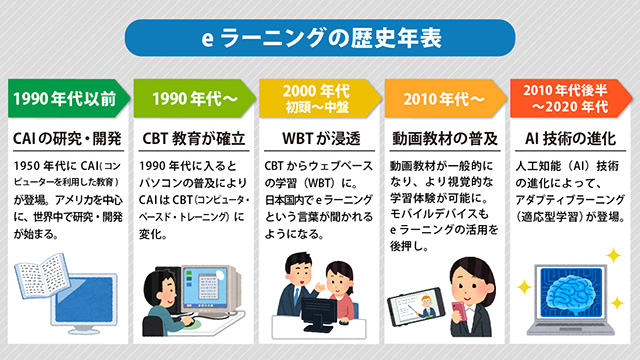2023.09.20
Digital Learning - Considering the History and Future Trends of e-Learning

In recent years, e-learning has established itself as one of the learning styles, and the background to its widespread adoption can be attributed to the many organizations that have promoted and supported it. Among them, NPO Digital Learning Consortium is the largest e-learning organization in the country, and it has been active for over 20 years with the aim of promoting the use of digital learning, including e-learning.
Our company is also a member.
In this article, I would like to introduce the Digital Learning Consortium and trace the history of e-learning. Furthermore, let's predict future market trends based on the current state of e-learning.
1. Role of the NPO Digital Learning Consortium

The Digital Learning Consortium (abbreviated as DLC) is a non-profit organization that works to promote the spread of digital learning, including e-learning. Its main efforts include promoting standardization, establishing guidelines, and providing related information, all aimed at raising awareness of digital learning.
The Digital Learning Consortium also conducts certification programs for qualifications related to digital learning, such as "e-Learning Professional (eLP)" and "SCORM Engineer." Human Science has staff who hold these qualifications and provides support to various companies as "e-Learning Professionals."
Six Initiatives of the Digital Learning Consortium
(1) Research Projects
・Investigation of the domestic and international situation regarding advanced technologies and teaching methods utilizing digital learning, trends in human resource development, and standardization trends.
(2) Certified Business
・Certification of e-learning specialists
・Certification of e-learning content and e-learning systems, as well as certification regarding their quality
(3) Research and Development Projects
・Technologies related to Digital Learning
・Research on standardization related to content and other matters
・Educational Technology related
・Practical technology development and demonstration experiments related to operational technologies
(4) Exchange and Proposal Activities
・Exchange and cooperation activities with related organizations both domestically and internationally from a global perspective
・Proposals to the government and support for policy implementation
(5) Education Business
・Improvement of knowledge and know-how for those responsible for or in charge of digital learning
・Development of e-learning specialists
(6) Dissemination and Awareness Activities
・Public relations and dissemination of various information obtained from the above activities, hosting events, and publishing books
The Digital Learning Consortium, which has been involved in these diverse businesses and has a history of over 20 years. Starting from the 2023 fiscal year, in order to achieve more effective human resource development support through extensive use of digital technologies, including e-learning, we have changed our name from the original "Japan e-Learning Consortium (abbreviated as: eLC)" established in 2001 to our current corporate name.
We will continue to pay attention to the activities of the Digital Learning Consortium, which is expected to lead the way in digital learning that is anticipated to further develop.
2. E-Learning Evolving with the Times

E-learning is a learning method born from the fusion of the evolution of digital technology and educational innovation. Its roots can be traced back to the 1950s with the emergence of "CAI (Computer-Assisted Instruction)". CAI began as a thought of whether education could be supported using computers, leading to research and development starting in the United States and around the world.
However, the technology could not keep up with the construction of an ideal system, and educational reform through CAI did not progress as hoped.
Such CAI has greatly developed since the 1990s.
■ 1990s and Beyond
In the 1990s, with the development of personal computers, CAI evolved into CBT (Computer-Based Training). CBT refers to a learning method that primarily uses CD-ROMs as teaching materials, providing content that combines various media such as text, images, audio, and video. In 1995, the explosively popular Windows 95 was released, leading to the widespread adoption of personal computers in households. Education through CBT was established.
■ Early to Mid 2000s
The term e-learning began to be heard in Japan around the year 2000. With the government launching the "e-Japan Initiative (*)", attention was focused on the "e-ification" of traditional media such as paper.
Recently, with the generalization of the internet, e-learning has shifted from CBT to web-based learning. The method of online learning is called WBT (Web-Based Training). With educational materials now available online, learners can easily access them anytime and anywhere, whether at home or in the workplace.
With the spread of WBT, Learning Management Systems (LMS) have become widespread, allowing educational institutions and companies to efficiently manage online learning. This period (2001) also saw the establishment of the Japan e-Learning Consortium, the predecessor of the Digital Learning Consortium.
■ 2010s and Beyond
The spread of high-speed internet has made video content an important element of e-learning. Through platforms like YouTube and dedicated learning platforms, lectures, explanations, and demonstrations are provided in video format, enabling a more visual learning experience.
Furthermore, mobile devices such as smartphones and tablets have become more accessible, supporting the feature of e-learning that allows for "learning anytime, anywhere." As a result, a more flexible learning environment that allows learners to study at their own pace has been further developed.
■ Late 2010s to 2020s
With the evolution of artificial intelligence (AI) technology, "adaptive learning" has emerged, which analyzes learners' progress and trends to provide appropriate learning content. This enables a "customized learning" experience tailored to individual learning styles.
In this way, e-learning has undergone significant evolution alongside technological innovation, bringing about revolutionary changes in the field of education. Thanks to the power of technology, learning environments tailored to individual learning styles are provided, allowing knowledge and skills to be acquired more effectively and efficiently.
(*) A concept aimed at realizing the Japanese-style IT society advocated by the Japanese government

3. Current Status of e-Learning
We have looked back at the history of e-learning up to this point, but e-learning continues to grow daily due to the evolution of technology and the transformation of education. In this chapter, we would like to focus on "the present of e-learning" and explore the current situation.
■ Further Spread After the COVID-19 Pandemic
Due to the impact of the global pandemic of the novel coronavirus, the spread of e-learning has rapidly advanced, and many learners have started to utilize online platforms for their studies. This is because face-to-face education and training were restricted, and online learning was chosen as an alternative.
■ Expansion of Corporate e-Learning Implementation
In the current era of remote work, many companies are actively adopting e-learning to enhance employee skills and improve training efficiency. Courses covering a variety of topics, such as onboarding, compliance training, and leadership development, are available, providing effective learning opportunities.
■ Evolution of Personalized Instruction through Artificial Intelligence
With the evolution of artificial intelligence, it has become possible to provide customized learning based on the learner's progress and skills. Adaptive learning platforms and AI tutors enhance the quality and effectiveness of learning.
■ Introduction of Virtual Reality and Augmented Reality
The implementation of e-learning materials utilizing Virtual Reality (VR) and Augmented Reality (AR) technologies has enabled immersive and realistic simulation experiences, allowing for the acquisition of more practical knowledge and skills. This is particularly effective for training that simulates real-life scenarios.
Due to the outbreak of the novel coronavirus, traditional face-to-face education has been restricted, leading to an increased demand for e-learning and its accelerated adoption. It is expected that e-learning will continue to permeate as one of the important learning methods in the future.
4. The e-learning market is expected to continue expanding

In recent years, the e-learning market has been growing due to advancements in technology and the impact of the COVID-19 pandemic. It is expected to continue evolving without losing momentum for the following reasons.
■ Significant Growth Forecast for the Global e-Learning Market
According to a study by Kenneth Research, a U.S. market research company that conducts market research reports across various industries, the global e-learning market is expected to see significant CAGR (Compound Annual Growth Rate) during the forecast period from 2020 to 2027.
Growth is anticipated to be driven by the increased adoption of microlearning and the application of gamification (the use of game elements in services not originally intended for gaming) in student classes.
■ Expectations for the Expansion of BtoB and BtoC Markets
In the BtoB market, the proliferation of mobile devices and the enhancement of video content have made e-learning more accessible, coupled with the increasing demand for workforce development by companies, leading to a deeper penetration across various industries than ever before. Similarly, in the BtoC market, the spread of learning methods utilizing mobile devices and social media, the provision of diverse services due to advancements in ICT (Information and Communication Technology), and the introduction of AI are expected to result in an increase in the number of users.
Both the BtoB and BtoC markets in e-learning are anticipated to continue expanding in the future.
The e-learning market has evolved in response to companies and individuals seeking new styles of learning. It is expected to continue to thrive in the future.
5. Summary

E-learning has undergone remarkable evolution over the past 30 years and has established itself as one of the learning methods.
E-learning, which has evolved from computer-based to web-based, and further to next-generation learning utilizing AI and VR, has increased its value by providing "high-quality learning" tailored to individual learning styles and needs.
In the future, we will continue to capture the flow of the times and the needs of people, integrating the latest technologies to pave the way for a new style of education.
We cannot take our eyes off the future of e-learning.
Human Science has extensive experience in the production of e-learning materials. We leverage our know-how in project management to support everything from planning and design of e-learning. Each project is assigned an experienced dedicated project manager, and a specialized consulting team provides solid support until delivery. If you have any concerns about material production, please feel free to consult with us.
For details about each service, please see below.
> Moodle Implementation Support and Operation
> e-Learning Material Production
> e-Learning Material Translation (Multilingual Support, Localization)












